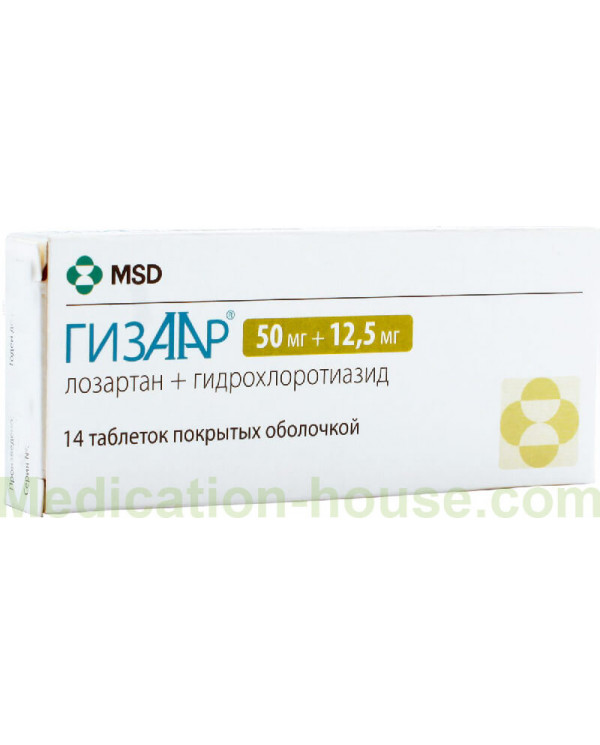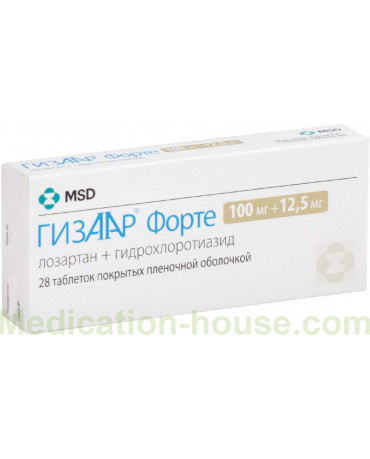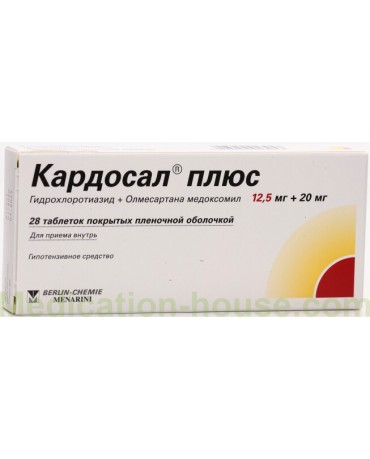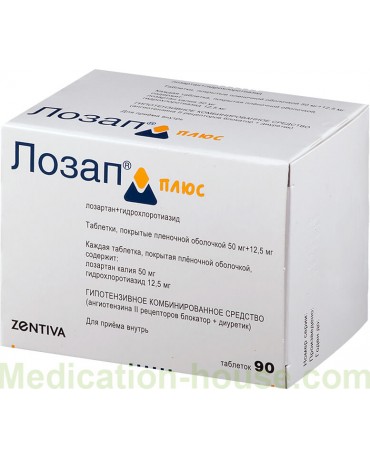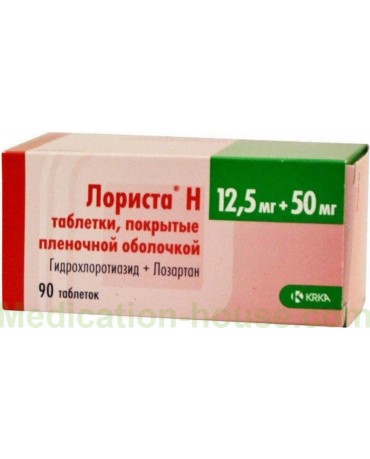Instruction for Hyzaar
Reed more and buy Hyzaar here
Hyzaar is a combined antihypertensive drug.
Release form and composition
Dosage form - coated tablets: oval, with a dividing line on one side and marking "717" on the other, yellow (7 or 14 pcs. In blisters, in a cardboard box 1 or 2 blisters).
Content of active ingredients in 1 tablet:
Losartan potassium - 50 mg;
Hydrochlorothiazide - 12.5 mg
Excipients: pregelatinized starch 1500, water lactose (spray dried), magnesium stearate, microcrystalline cellulose (Avicel PH102).
Shell composition: hydroxypropyl methylcellulose (6 cps), hydroxypropyl cellulose (with less than 0.3% silicon), carnauba wax, quinoline yellow aluminum varnish (E104), titanium dioxide (E171).
Pharmacodynamics and pharmacokinetics
The active substances of Hyzaar - losartan and hydrochlorothiazide - are characterized by an additive hypertensive effect, since they lower blood pressure (BP) more significantly than each of the components separately. It is believed that this effect is due to the complementary action of both components of the drug. Hydrochlorothiazide has a diuretic effect, which leads to a decrease in the concentration of potassium in the blood serum, an increase in the activity of blood plasma renin (ARP), an increase in the content of angiotensin II and stimulation of the production of aldosterone.
The use of losartan suppresses all the physiological effects of angiotensin II and, due to the decrease in the effects of aldosterone, can help to reduce the loss of potassium caused by taking a diuretic. Losartan is also characterized by a moderate and transient uricosuric effect. Hydrochlorothiazide contributes to a slight increase in blood uric acid levels. Its combination with losartan can reduce the severity of symptoms of hyperuricemia caused by taking a diuretic.
Losartan selectively binds to AT1 receptors without binding and blocking other hormone receptors and ion channels responsible for regulating the functions of the cardiovascular system. Also, losartan is not an inhibitor of the angiotensin-converting enzyme (ACE, kininase II), which causes the destruction of bradykinin. For this reason, the effect of losartan on the body does not enhance the bradykinin-mediated effects or the occurrence of edema.
The mechanism of the antihypertensive action of thiazides has not yet been studied. Usually these compounds do not affect normal blood pressure readings.
Hydrochlorothiazide belongs to the group of diuretics and antihypertensive drugs. It affects the reabsorption of electrolytes in the distal renal tubules. Hydrochlorothiazide approximately equally increases the excretion of chlorine and sodium ions. Natriuresis is sometimes accompanied by small losses of bicarbonate and potassium ions. When taken orally, the diuretic effect appears within 2 hours, reaches a maximum value after 4 hours and lasts 6-12 hours.
In patients with left ventricular hypertrophy and arterial hypertension, losartan, including in combination with hydrochlorothiazide, reduces the risk of cardiovascular disease and mortality.
Losartan prevents an increase in systolic and diastolic blood pressure during the infusion of angiotensin II. At the moment of reaching the maximum content of losartan in the blood plasma after taking Hyzaar at a dose of 100 mg, the above-described effect of angiotensin II is suppressed by about 85%, and a day after a single and multiple doses - by 26–39%.
Losartan has no effect on autonomic reflexes and does not change the concentration of norepinephrine in blood plasma for an extended period of time.
When taken orally, losartan is well absorbed and metabolized during “primary passage” through the liver, where it forms an active carboxylated metabolite and inactive metabolites. The systemic bioavailability of this compound in tablet form is about 33%. Average maximum concentrations of losartan and its metabolic products are recorded after 1 hour and after 3 hours, respectively. When Hyzaar was taken with food, no clinically significant changes in the content of losartan in blood plasma were found.
Losartan and its active metabolite are able to bind to blood plasma proteins (mainly albumin) by at least 99%. Hydrochlorothiazide crosses the placental (blood-brain is inaccessible to him) barrier and is excreted in breast milk.
Plasma clearance of losartan and its active metabolite is approximately 600 and 50 ml / min, respectively. The renal clearance of the above compounds is approximately 74 and 26 ml / min, respectively. With oral administration of losartan, approximately 4% of the dose is excreted through the kidneys unchanged and approximately 6% of the dose is excreted as an active metabolite. After oral administration, the plasma concentrations of losartan and its active metabolite decrease polyexponentially, with the final elimination half-life of about 2 and 6-9 hours, respectively.
When Hyzaar is taken at a dosage of 100 mg once a day, there is no significant accumulation in the blood plasma of either losartan or its active metabolite. These substances are excreted through the kidneys and through the intestines with bile.
Hydrochlorothiazide is not metabolized and is excreted through the kidneys at a significant rate. Monitoring the content of the substance in the blood plasma for 24 hours showed that its half-life is 5.6-14.8 hours. At least 61% of the dose taken orally is excreted in its original form within one day.
When Hyzaar was taken orally by patients with mild and moderate alcoholic cirrhosis of the liver, the content of losartan and its active metabolite in the blood plasma turned out to be 5 and 1.7 times higher than the standard values, respectively.
Indications for use
Arterial hypertension (in patients with indications for combination therapy);
Reducing the risk of cardiovascular disease and mortality in case of left ventricular hypertrophy and arterial hypertension.
Contraindications
Age under 18;
Severe liver dysfunction;
Severe renal dysfunction (creatinine clearance (CC) less than 30 ml / min);
Anuria;
Glucose-galactose malabsorption syndrome, lactose intolerance, lactase deficiency;
The period of pregnancy and breastfeeding;
Hypersensitivity to sulfonamide derivatives and / or drug components.
It is recommended to prescribe Hyzaar with caution to patients with renal insufficiency (CC 30-50 ml / min), stenosis of the artery of a single kidney, bilateral stenosis of the renal arteries, disturbances in the water-electrolyte balance of the blood (including those caused by vomiting or diarrhea (hyponatremia, hypochloremic alkalosis, hypomagnesemia) , hypokalemia)), gout, hypercalcemia, hyperuricemia, diabetes mellitus, bronchial asthma and aggravated allergic history, hypovolemia (including taking high doses of diuretics), systemic connective tissue diseases (including systemic lupus erythematosus); while taking non-steroidal anti-inflammatory drugs, including cyclooxygenase (COX) -2 inhibitors.
Instructions for the use of Hyzaar: method and dosage
Hyzaar is taken orally, regardless of the meal.
Recommended dosage: 1 tablet 1 time per day; in the absence of a therapeutic effect after three weeks of treatment, the dose can be increased to 2 tablets once a day.
The maximum daily dose of the drug is 2 tablets.
For elderly patients, the selection of the initial dose is not required.
Side effects
In clinical studies, the most frequently observed adverse reactions were weakness, dizziness, and fatigue.
Post-marketing experience with the drug has identified additional side effects:
Digestive system: rarely - diarrhea, hepatitis;
Immunopathological and allergic reactions: anaphylactic reactions, edema of the larynx and glottis with the development of airway obstruction or other symptoms of angioedema, including edema of the face, lips, tongue and / or pharynx; rarely - vasculitis (Shenlein-Henoch purpura);
Dermatological reactions: urticaria, increased photo and photosensitivity;
Respiratory system: possibly - cough;
Laboratory indicators: rarely - slight hyperkalemia (does not require discontinuation of the drug), a transient increase in the activity of alanine aminotransferase.
Overdose
Overdose symptoms can occur due to dehydration and lack of electrolytes against the background of excessive diuresis, and are manifested by a pronounced decrease in blood pressure and tachycardia.
Special instructions
The appointment of Hyzaar in combination with other antihypertensive drugs is shown.
The effect of drugs on the renin-angiotensin system can increase the content of creatinine and urea in the blood in patients with bilateral renal artery stenosis or stenosis of an artery of a single kidney.
The presence of losartan suppresses the function of the renin-angiotensin system and can cause changes in renal function, renal failure. The changes are reversible and disappear after drug withdrawal.
While taking the drug, patients may develop symptomatic arterial hypotension.
Treatment should be accompanied by regular monitoring of water and electrolyte balance, which will allow timely detection of clinical signs of hyponatremia, dehydration, hypochloremic alkalosis, hypokalemia, hypomagnesemia. Serum electrolyte levels should be checked if vomiting or intercurrent diarrhea occurs.
According to the instructions, Hyzaar may impair glucose tolerance, so some patients may need to adjust the dose of insulin and other hypoglycemic agents.
Thiazides can cause a slight and episodic increase in serum calcium concentration and reduce the excretion of calcium in the urine. Severe hypercalcemia may indicate latent hyperparathyroidism.
Since the effect of thiazides on calcium metabolism can distort the parameters of studies of the function of the parathyroid glands, the administration of a thiazide diuretic should be discontinued before the study.
Against the background of therapy with thiazide diuretics, the content of triglycerides and cholesterol in the blood may increase, a hypersensitivity reaction may develop, and systemic lupus erythematosus may progress or worsen.
The combined composition of the drug can reduce the severity of hyperuricemia and / or the risk of developing gout, since losartan reduces the level of uric acid.
Drug interactions
The combination of the drug with potassium-sparing diuretics, including spironolactone, triamterene, amiloride, potassium salts, or potassium-containing supplements may increase serum potassium levels.
The therapeutic effect of the drug can be reduced by the combination with non-steroidal anti-inflammatory drugs.
Concomitant use with ethanol, barbiturates, opioid analgesics may increase the risk of orthostatic arterial hypotension.
When combined with other antihypertensive drugs, an additive effect occurs.
The absorption of hydrochlorothiazide disrupts the presence of anionic exchange resins. With the simultaneous administration of colestyramine or colestipol, the absorption of hydrochlorothiazide is significantly reduced.
The use of Hyzaar with adrenocorticotropin, corticosteroids leads to a strong decrease in electrolyte levels, hypokalemia.
The drug enhances the effect of tubocurarine and other non-depolarizing muscle relaxants.
A combination with lithium preparations is not recommended, since it leads to a decrease in the renal clearance of lithium, increases the risk of developing its toxic effect.
Terms and conditions of storage
Keep out of reach of children at a temperature of 15-30 ° C.
The shelf life is 3 years.
Reviews about Hyzaar
According to the available data, reviews of Hyzaar are overwhelmingly favorable. Patients indicate the availability and high efficiency of the drug in the treatment of hypertension, provided that it is taken for at least 1 month. It quickly stabilizes blood pressure and brings it to normal levels, which is why Hyzaar is recommended by many doctors. This drug makes it possible to improve the treatment of both arterial hypertension and related diseases.
Terms of sell
You don't need a prescription to buy Hyzaar.

